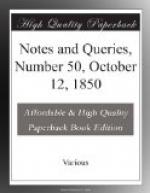“WILLIAM EVANS was born in this county [Monmouthshire], and may justly be accounted the Giant of our age for his stature, being, full two yards and a half in height. He was porter to King Charles I., succeeding, Walter Persons [sic] in his place, and exceeding him two inches in height, but far beneath him in an equal proportion of body; for he was not onely what the Latines call compernis, knocking his knees together, and going out squalling with his feet, but also haulted a little; yet made a shift to dance in an antimask at court, where he drew little Jeffrey, the dwarf, out of his pocket, first to the wonder, then to the laughter, of the beholders. He dyed Anno Dom. 1630.” Ibid. (Monmouthshire), p. 54.
From these extracts it will be seen that the Christian name of Parsons was Walter, not William, as stated by Harwood. William was the Christian name of Evans, Parsons’ successor. The bas-relief mentioned by the same writer represents William Evans and Jeffrey Hudson, his diminutive fellow-servant. It is over the entrance of Bull-head Court, Newgate Street; not “a bagnio-court,” which is nonsense. On the stone these words are cut: “The King’s Porter, and the Dwarf,” with the date 1660. This bas-relief is engraved in Pennant.
There is a picture of Queen Elizabeth’s giant porter at Hampton Court but I am not aware that any portrait of Parsons is preserved in the Royal Collections.
EDWARD F. RIMBAULT.
* * * * * {315}
EISELL AND WORMWOOD WINE.
(Vol. ii., p. 249.)
If Pepys’ friends actually did drink up the two quarts of wormwood wine which he gave them, it must, as LORD BRAYBROOKE suggests, have been rendered more palatable than the propoma which was in use in Shakspeare’s time. I have been furnished by a distinguished friend with the following, among other Notes, corroborative of my explanation of eisell:
“I have found no better recipe for making wormwood wine than that given by old Langham in his Garden of Health; and as he directs its use to be confined to ’Streine out a little spoonful, and drinke it with a draught of ale or wine,’ I think it must have been so atrociously unpalatable, that to drink it up, as Hamlet challenged Laertes to do, would have been as strong an argumentum ad stomachum as to digest a crocodile, even when appetised by a slice of the loaf.”
It is evident, therefore, that but small doses of this nauseously bitter medicament were taken at once, and to take a large draught, to drink up a quantity, “would be an extreme pass of amorous demonstration sufficient, one would think, to have satisfied even Hamlet.” Our ancestors seem to have been partial to medicated wines; and it is most probable that the wormwood wine Pepys gave his friends had only a slight infusion of the bitter principle; for we can hardly conceive that such “pottle draughts” as two quarts could be taken as a treat, of such a nostrum as the Absinthites, or wormwood wine, mentioned by Stuckius, or that prescribed by the worthy Langham.




